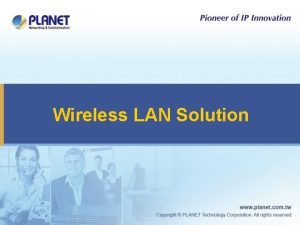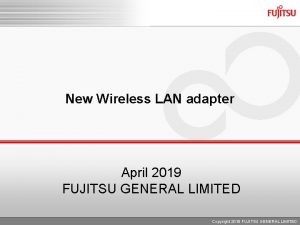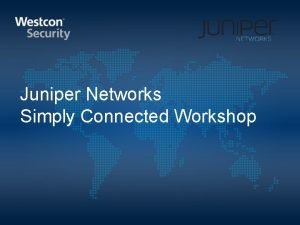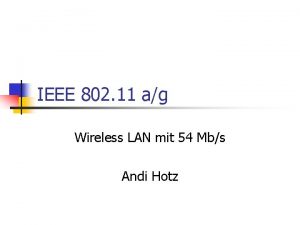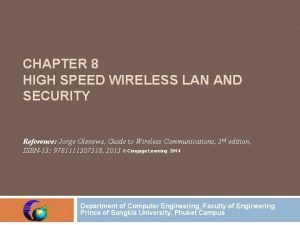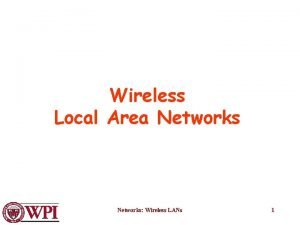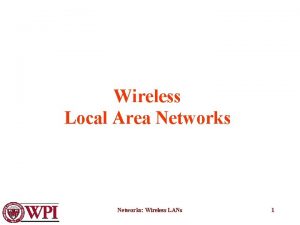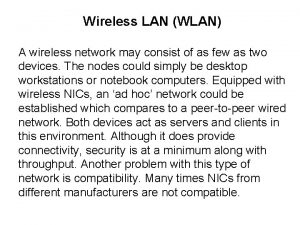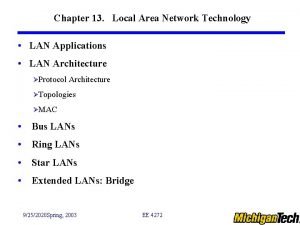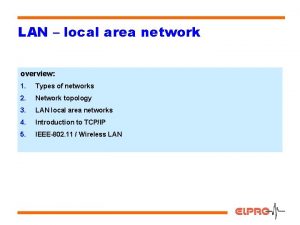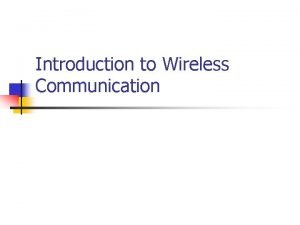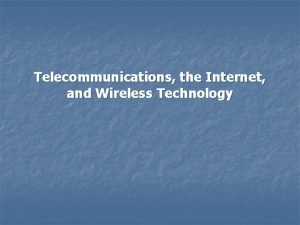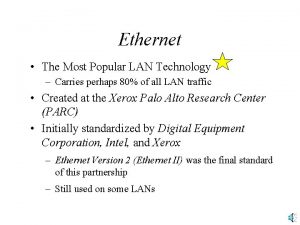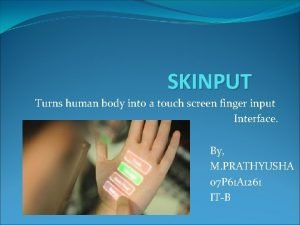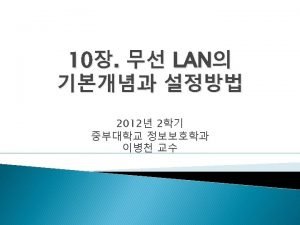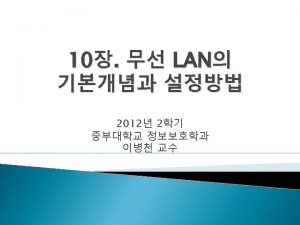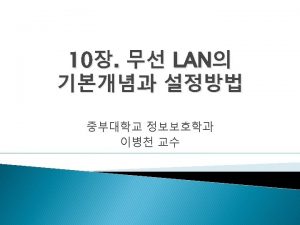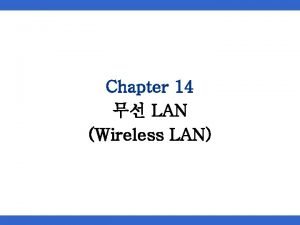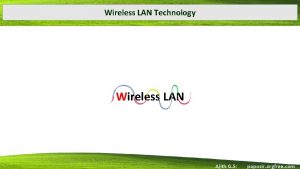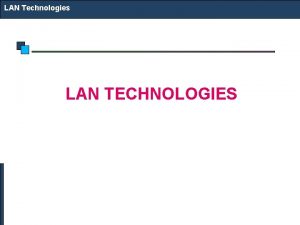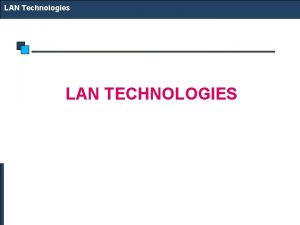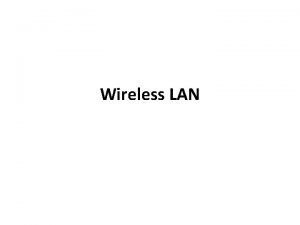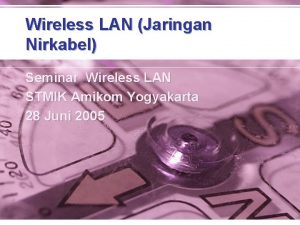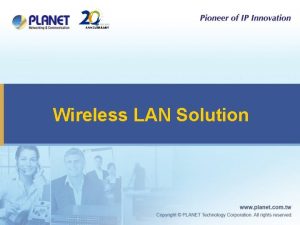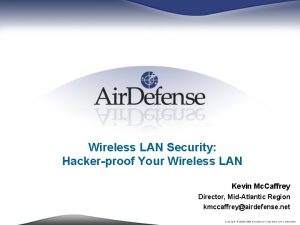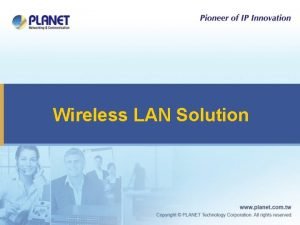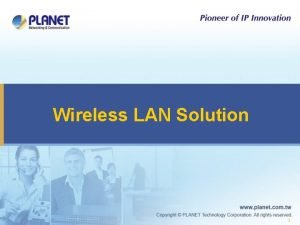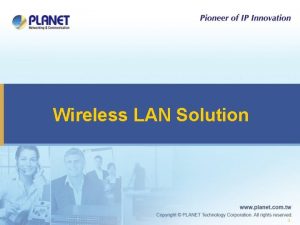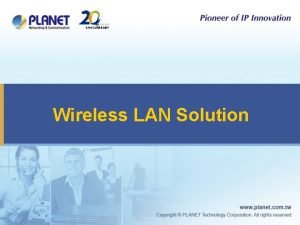Wireless LAN Technology Chapter 13 Wireless LAN Applications




















- Slides: 20

Wireless LAN Technology Chapter 13

Wireless LAN Applications n n LAN Extension Cross-building interconnect Nomadic Access Ad hoc networking

LAN Extension n Wireless LAN linked into a wired LAN on same premises n Wired LAN n n n Backbone Support servers and stationary workstations Wireless LAN n n Stations in large open areas Manufacturing plants, stock exchange trading floors, and warehouses

Multiple-cell Wireless LAN

Cross-Building Interconnect n Connect LANs in nearby buildings n n n Wired or wireless LANs Point-to-point wireless link is used Devices connected are typically bridges or routers

Nomadic Access n Wireless link between LAN hub and mobile data terminal equipped with antenna n n Laptop computer or notepad computer Uses: n n Transfer data from portable computer to office server Extended environment such as campus

Ad Hoc Networking n n Temporary peer-to-peer network set up to meet immediate need Example: n Group of employees with laptops convene for a meeting; employees link computers in a temporary network for duration of meeting

Wireless LAN Requirements n n n n n Throughput Number of nodes Connection to backbone LAN Service area Battery power consumption Transmission robustness and security Collocated network operation License-free operation Handoff/roaming Dynamic configuration

Wireless LAN Categories n n n Infrared (IR) LANs Spread spectrum LANs Narrowband microwave

Strengths of Infrared Over Microwave Radio n Spectrum for infrared virtually unlimited n n Infrared spectrum unregulated Equipment inexpensive and simple Reflected by light-colored objects n n Possibility of high data rates Ceiling reflection for entire room coverage Doesn’t penetrate walls n n More easily secured against eavesdropping Less interference between different rooms

Drawbacks of Infrared Medium n Indoor environments experience infrared background radiation n Sunlight and indoor lighting Ambient radiation appears as noise in an infrared receiver Transmitters of higher power required n n Limited by concerns of eye safety and excessive power consumption Limits range

IR Data Transmission Techniques n n n Directed Beam Infrared Ominidirectional Diffused

Directed Beam Infrared n n n Used to create point-to-point links Range depends on emitted power and degree of focusing Focused IR data link can have range of kilometers n Cross-building interconnect between bridges or routers

Ominidirectional n n n Single base station within line of sight of all other stations on LAN Station typically mounted on ceiling Base station acts as a multiport repeater n n Ceiling transmitter broadcasts signal received by IR transceivers transmit with directional beam aimed at ceiling base unit

Diffused n n All IR transmitters focused and aimed at a point on diffusely reflecting ceiling IR radiation strikes ceiling n n Reradiated omnidirectionally Picked up by all receivers

Spread Spectrum LAN Configuration n Multiple-cell arrangement (Figure 13. 2) Within a cell, either peer-to-peer or hub Peer-to-peer topology n n No hub Access controlled with MAC algorithm n n CSMA Appropriate for ad hoc LANs

Spread Spectrum LAN Configuration n Hub topology n n n Mounted on the ceiling and connected to backbone May control access May act as multiport repeater Automatic handoff of mobile stations Stations in cell either: n n Transmit to / receive from hub only Broadcast using omnidirectional antenna

Narrowband Microwave LANs n n Use of a microwave radio frequency band for signal transmission Relatively narrow bandwidth Licensed Unlicensed

Licensed Narrowband RF n n Licensed within specific geographic areas to avoid potential interference Motorola - 600 licenses in 18 -GHz range n n n Covers all metropolitan areas Can assure that independent LANs in nearby locations don’t interfere Encrypted transmissions prevent eavesdropping

Unlicensed Narrowband RF n Radio. LAN introduced narrowband wireless LAN in 1995 n n Uses unlicensed ISM spectrum Used at low power (0. 5 watts or less) Operates at 10 Mbps in the 5. 8 -GHz band Range = 50 m to 100 m
 Lan 1232
Lan 1232 Telecommunications, the internet, and wireless technology
Telecommunications, the internet, and wireless technology Fglair app
Fglair app Juniper wlm series wireless lan managers
Juniper wlm series wireless lan managers Juniper wlm series wireless lan managers
Juniper wlm series wireless lan managers Wireless lan 802
Wireless lan 802 High speed wireless lan
High speed wireless lan Wireless lan protocols
Wireless lan protocols Wireless lan protocols
Wireless lan protocols What does a wireless lan (wlan) act as to a wired network?
What does a wireless lan (wlan) act as to a wired network? Lan switching and wireless
Lan switching and wireless Applications of lan
Applications of lan A type of wireless local area network technology
A type of wireless local area network technology History of wireless technology
History of wireless technology Telecommunications, the internet, and wireless technology
Telecommunications, the internet, and wireless technology Most popular lan
Most popular lan Applications of skinput technology
Applications of skinput technology Recombinant dna technology applications
Recombinant dna technology applications Recombinant dna technology applications
Recombinant dna technology applications Rdna technology applications
Rdna technology applications Recombinant dna technology applications
Recombinant dna technology applications
